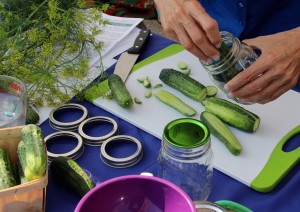Local nutrition expert teaches proper canning to backyard gardeners
Chronicle Media — August 31, 2015
Laura Barr, University of Illinois Extension nutrition and wellness educator, demonstrates how to make dill pickles during one of her food preservation demonstrations at the Aurora Farmers Market. (Photo courtesy U of I Extension Kendall/Kane)
Whether you grow your own, or frequent your local farmers market, there is nothing like the taste of fresh, ripe produce.
“Like many others, this is my favorite time of the year – harvest time,” said Laura Barr, University of Illinois Extension nutrition and wellness educator. “I have ‘put up’ strawberry preserves, green beans, dill pickles, corn relish, tomato sauce and salsa with the fresh, abundant produce of the season.”
Barr is sharing samples and tips from projects like these during food preservation demonstrations with the Aurora Farmers Market this summer.
Here are a few of steps to success:
Produce Selection
The timing for produce selection depends on what is ready and in abundance, and that should be in mind when harvesting from the garden or purchasing at the market.
“Choose the best pieces for preserving,” Barr said. “Look for the ripest, firmest produce, with no visible bruising, signs of spoilage or insect damage. It may seem counter-intuitive, but those slightly flawed items can be used for table use right away.”
Proper Method
The plentiful harvest lasts a short time, but the fresh produce can be preserved by freezing, drying or canning.
“Choosing the method of preservation may seem tricky, but with a few scientific guidelines, the decision becomes simpler,” Barr said.
When freezing, vegetables and fruit lose texture because plant cells expand and burst, and when thawed, they become soft.
“The more water in the fruit, the more structure lost. For instance, if you freeze grapes and bananas and thaw them both, the grapes will be soft and the banana will hold its form,” Barr said. “Vegetables need to be blanched prior to freezing because it prevents enzyme actions which can cause loss of nutrients, texture, flavor, and appearance.”
Additionally, blanching – which is placing produce in boiling water for a short time and cooling quickly – removes dirt, destroys bacteria and softens the product for easier packing. For specific times for each product, consult the guide at http://nchfp.uga.edu/.
“Under-blanching activates enzymes, which make it worse than no blanching, and over-blanching destroys nutrients, color and flavor,” Barr explained.
A dehydrator is a great tool for removing moisture from product to make it safe and last longer.
“We can dry fruit, vegetables, herbs, beans, seeds and meat jerkies with proper methods and continue to enjoy the harvest into the winter months and beyond,” Barr explained.
Canning is an effective method to customize produce like low-salt or no salt options. The two methods are hot-water bath and pressure canning determined by the pH – the percent hydrogen or acidity – of the product.
“It’s a science, and the procedures need to be followed according to each step as described in a tested-recipe. This ensures a safe product, ” Barr said.
Getting Started
For new preservers, Barr recommends a hot-water bath system as a good first choice method. Equipment includes a large cooking pot, Mason or Ball brand canning jars, canning jar lifter with rubber grips, stainless steel ladle, a canning funnel, kitchen tongs and bubble remover. Keeping an open and organized work area will provide an efficient flow of products.
Final Reminders
Barr reminds seasoned canners to use new lids every time, throw away rusted or bent bands, and dispose of jars that are unusual in appearance or have an odor. Also remember to:
– Wipe the jars, lids, and rings dry after use to keep them from rusting, and store in a cool, dry place.
– Add a few tablespoons of vinegar if you are boiling in hard water so there will not be mineral deposits on your jars.
– Use a teaspoon or two of lemon juice or ascorbic acid to keep fruit bright and fresh.
– Stay up-to-date on methods, changes and recommendations from experts. For example, manufacturers are reporting now that lids do not need to be simmered before use.
SIDEBAR INFO BOX
Save the Date
Laura Barr, University of Illinois Extension nutrition and wellness educator, will demonstrate how to make apple butter at the Aurora Farmers Market on Saturday, Sept. 12, at 10 a.m. There also will be a taste testing of completed recipes.
University of Illinois Extension and the National Center for Home Food Preservation (NCHFP) can provide the latest news on home food preservation. For more on the NCHFP, visit http://nchfp.uga.edu.
For information about food preservation and other Nutrition and Wellness programs through the University of Illinois Extension, contact Laura Barr at llbarr@illinois.edu or (630) 584-6166, or visit http://web.extension.illinois.edu/dkk/.
— Local nutrition expert teaches proper canning to backyard gardeners —



